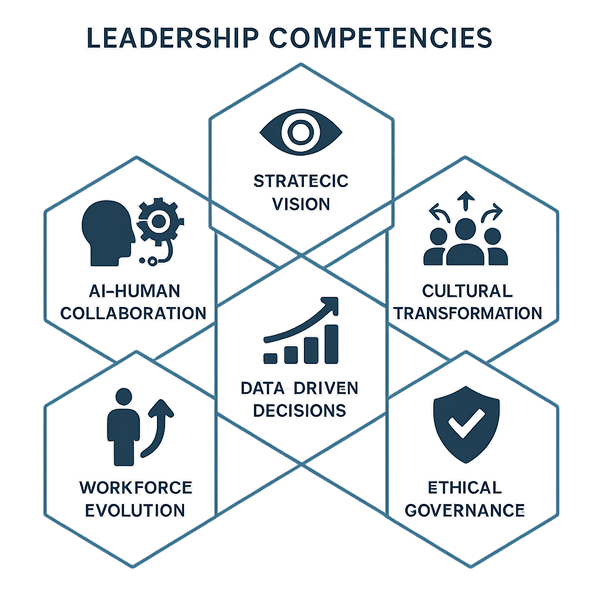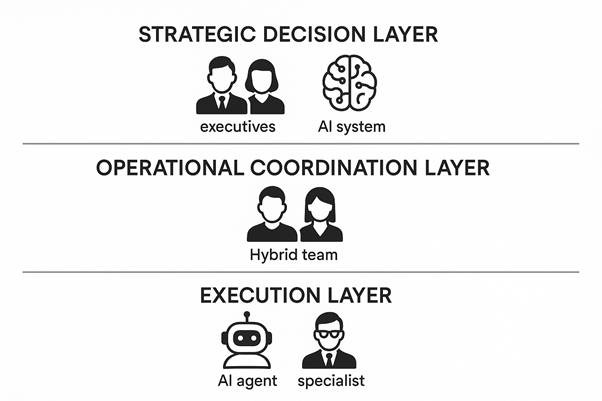How AI Is Redefining Leadership in the Next Decade
The executive playbook for leading in an age where artificial intelligence becomes your most strategic business partner

When Satya Nadella became CEO of Microsoft in 2014, he took the reins of a company struggling to stay relevant in a mobile-first world. Microsoft is today leading the AI revolution with a market share of over $3 trillion. This turnaround required fundamentally re-thinking what it means to lead when machines are strategic partners and not just tools.
And it is happening right now! The data is alarming: 94% of all employees report familiarity with AI tools, and yet only 1% of companies have reached true AI maturity and have AI drive real outcomes for the business. The largest challenge faced by executive leadership is the gap between AI uptake and AI mastery.
The Leadership Crisis Hiding in Plain Sight
Sarah Chen assumed that her technology consulting business was at the vanguard. As CEO, she was deeply investing in AI tools, hiring data scientists, and prescribing her 200 employees to “play with ChatGPT” and similar platforms. Six-months later, productivity had not really increased, and her top contributors were quietly complaining about “AI adding more work, not less.”
Chen’s experience highlighted a bigger crisis that is revealed in recent research.
First, 76% of senior leaders use generative AI at least one to two times a week but only 51% of front-line employees are using generative AI regularly.
The bottom line: Employees are three times more often using AI than senior leaders think, and in many cases, these employees are using AI around their leaders and their management practices.
“We are watching the demise of information-based leadership,” states Paul McDonagh-Smith, the faculty director for MIT Sloan who researches AI-enabled organizations. “The executive who derives authority from controlling the flow of information is about to be an anachronism.”
The statistics bear out such a stark judgment. McKinsey’s latest research shows traditional middle management functions, such as gatekeeping information, assessing performance and allocating resources, are being automated by AI systems who are faster, more accurate, and do not discriminate. Yet, nearly all executives are still behaving as though we are at the reign of hierarchy for business success.
The Six Competencies That Define AI-Era Leadership

Our analysis of breakthrough research from MIT, McKinsey, BCG, and Harvard Business Review reveals what distinguishes successful executives from executives that struggle to stay relevant. The future will belong to executives who demonstrate mastery of six clusters of competencies.
The AI-Human Collaboration Architect
Management as we knew it, is generally based on human teams for technology support. The role of the AI- Human Collaboration Architect will lead to a hybrid team, where artificial intelligence is a trusted collaborator. AI should no longer be looked at as a highly sophisticated spreadsheet.

Ex- Founders and current CEO of NVIDIA, Jensen Huang, restructured the internal operations of NVIDIA around human-AI collaboration rather than turning AI into a product and selling it. Human engineers now work directly with AI systems to expedite the cycles of chip design. AI agents attend business strategy meetings, contributing to market analysis and technical feasibility tests in real time.
A successful and relevant executive, is one who is thinking “humans multiplied by machines,” versus “humans plus machines.” This reflects a shift in mindset from additive efficiencies to exponential capability.
Practical Use: To begin, identify 3 important decisions your organization is making each month, and draw a map showing how AI may add differentiated analytical recommendations while the human provides strategic context and ethical considerations. From there, try implementing more structured human-AI decision-making processes, with the idea that the AI’s role is more akin to an expert, multi-disciplinary team member rather than a research tool.
Mastering Adaptive Strategic Vision

For decades, the strategic planning cycle served executives in the form of annual retreats, quarterly reviews, and multiyear road maps; which has not kept pace with the rapid (almost daily) accelerating pace of AI’s capabilities.
MIT research shows that the most effective leaders in AI have two, simultaneous strategies: rapid experimentation for tactical learning and slower, systematic strategy refinement for sustainable advantage. This two track approach matches nicely to Nobel Prize-winning researcher Daniel Kahneman’s notion of “fast and slow” thinking, but applied to developed organizational strategy, rather the cognitive processing of an individual.
Marc Benioff, CEO of Salesforce provided a perfect example of this in practice. Salesforce’s CRM (customer relationship management) platform develops and improves its core platform in a systematic manner, while employing hundreds of AI experiments in parallel, and quickly integrating the successful innovations, and discarding the failures immediately without penalty. Salesforce is able to stay strategically coherent and gain first-mover advantages in new AI business applications.
Implementation Strategy: Spend 70% of your strategic resources on systematic capability building, and 30% on high-risk, high learning AI experimentation. You may have to determine different sets of measurement for the success of each track - you may want to measure systematic investments by estimated value creation over the long term, while measure the experimental investments by the velocity of learning.
Techniques for Leading Cultural Change at Scale
Possibly one of the most underestimated challenges of changing an organization by incorporating AI is cultural. BCG’s studies show that workers at fully immersed AI organizations report 46% higher anxiety about their job security than those at organizations that are less advanced (34%). Well, this is the new reality of leadership navigating technological transformation that undermines traditional definitions of work.
The key point is that the anxiety around AI is really not about AI. The anxiety is actually about identity, purpose, and value in a world where tasks that were the sole domain of humans are now the domain of machines.
Reed Hastings faced a version of this when Netflix shifted from a DVD distribution model to a streaming approach. While the technological shift was difficult and complex, the cultural shift to get people to rethink their roles in a very different business model was the much harder and ultimately more important part of the change.
Leadership Framework: Alleviate anxiety with AI by operating in three concurrent ways: provide transparent and open communication about roles evolving (not going away), make specific investments to build people’s workforce capability to upskill humans for AI enabled roles, and share and celebrate stories of individual and team success using human and AI collaboration.
Building Ethical AI Governance Without Impeding Innovation

The speed and safety dilemma has paralyzed many executives. If you go too fast, AI systems introduce bias and violate privacy standards; go too slow, and competitors gain market share that won’t be easily overcome.
According to McKinsey research, employees trust their employer to make ethical decisions about deploying AI more than they do universities, large tech companies or start-ups. Trust includes an opportunity and obligation. Leaders who develop strong ethical principles early build trust with employees, establish credibility with regulators, and can move as quickly with innovation.
Real World Implementation: Establish an “ethical velocity” as researchers call it, rapid experimentation within clear ethical boundaries rather than long processes to examine every innovation. You should establish ethical principles that are universally accepted (detection of bias, privacy protection, and human oversight of high-stakes decisions), while allowing rapid iterations within those principles.
Building Data-Driven Decision Systems
An executive in the era of AI needs to understand the concepts of statistical significance and limitations of models and quality of data requirements. That is not because they should get into the technical details, but because they’re the fundamental business concepts that inform judgment.
This doesn’t mean executives need to get computer science degrees. It means to understand when AI recommendations require high confidence versus when human judgment should override the algorithmic suggestions. It also means recognizing when data quality issues could compromise AI insights and when competitive dynamics require decisions despite incomplete information.
Development Approach: Spend time with your organization’s data scientists and AI engineers, to learn about the business implications of the model’s confidence interval, data limitations for training, and the assumptions made in algorithms. This understanding should be part of regular strategic conversation.
Orchestrating Workforce Transition

The most difficult executive challenge may be navigating human capital transition while maintaining organizational performance. Findings from BCG research suggests that thorough AI training and learning requires at least five hours along with face to face direct coaching for employees to feel more comfortable, Nonetheless, most organizations offer minimal AI enablement to their employees.
The opportunity cost is staggering. According to McKinsey data, when leaders model AI enablement, employee mood rises from 15% positive to 55% positive. When employees are trained and equipped with the right tools, they begin innovating with AI, discovering ways to apply the technology that the purely technical team missed.
Strategic Priority: Recognize that AI literacy is a critical business skill, similar to financial literacy or communication skills. Support and invest in a robust training program, but focus the training on business applications, not technical details. We want our workforce members to think in creative ways about human-AI.
Redesigning Organizations for AI-First Operations
Traditional organizational charts, that is rigid pyramids with clear reporting lines, cannot accommodate AI’s dynamic collaboration requirements. The most innovative organizations are shifting toward what researchers term “neural organizational frameworks”: adaptive systems where human and AI agents collaborate based on situational needs rather than hierarchical position.
The Three-Layer AI-Integrated Organization

Strategic Decision Layer: Human executives collaborate with AI systems on strategic vision, ethics-based frameworks, and high-stakes decisions requiring human accountability. AI systems will support market evaluations, scenario modelling, and risk assessment, while human executives will provide strategic judgment and stakeholder management.
Operational Coordination Layer: Hybrid teams of humans in frontline leadership roles and AI supervisory roles work together to streamline workflows, deploy resources, and maintain strategic alignment. AI handles all routine coordinating and performance tracking, while humans handle exceptions, conflicts, and strategic pivots.
Execution Layer: Independent AI agents will perform routine operational activities, while human agents will focus on creative, relationship-building problem solving, and activities involving emotional intelligence and/or ethical reasoning.
Companies like Tesla, Amazon, and Microsoft are developing variations of this structure, integrating AI systems into strategic planning, operational optimization, and tactical execution as organizations maintain accountability and creative direction.
From Annual Planning to Continuous Adaptation
Perhaps most fundamentally, organizations in the age of AI should move from periodic planning cycles to continuous strategic adaptation. When AI systems can analyse changes in the market, competitive moves, and internal performance metrics in real-time, the quarterly business review will become an artifact of information scarcity rather than a strategy period cost.
Leading executives are already introducing “always-on” strategic processes whereby the AI systems continually monitor performance against objectives, note emerging opportunities or threats, and suggest tactical adaptations. Humans manage the strategic direction, ethical boundaries, and decisions which involve judgment about long-term consequences, or impact on other stakeholders.
The Competitive Reality: Adapt or Become Irrelevant

There is no ambiguity in the data about what happens to organizations that do not seek to lead the move to AI. McKinsey has positioned a global productivity potential for AI at $4.4 trillion - but only for organizations achieving true human-AI collaboration at scale. The Boston Consulting Group recently observed that organizations that are actively reshaping workflows with AI exhibit measurably greater value than organizations that are simply deploying AI tools within the existing workflow.
If this were not enough of a reason to justify the disruptive leadership pedagogies in a hybrid AI work environment, there is another dimension - that of time. The window of strategic advantage is already closing quickly. Only 1% of organizations today are considered to be at an AI maturity level, and the organizations that are in transition are already attracting disproportionate amounts of real talent, customer loyalty, and market position. The compounding effects of efficiency (financed by AI and its applications), a characteristic of these organizations, create increasingly insurmountable advantages for competitors.
The Leadership Legacy You’ll Leave
Every transformational technology produces two types of leaders: transformational and reactive. The internet created leaders such as Jeff Bezos but also destroyed countless retail executives who treated e-commerce as a channel rather than a fundamental business model shift. Mobile technology elevated Tim Cook while marginalizing leaders who viewed smartphones as improved phones rather than computing platforms.
AI represents a transformation of similar magnitude, but compressed into a dramatically shorter timeframe. The executive skills that built the digital economy, data-driven decision making, agile development, customer-centric design, still apply but are insufficient. You will need fundamentally new capabilities: orchestrating human-AI collaboration, continuous strategic adaptation capability, and leading through disruptive technological change that challenges fundamental assumptions about work, the value creation process and competitive advantage.
The choice for every executive is clear: either master these new leadership competencies and approaches now while the transformation is still underway, or be content with defending against competitors that do. Ultimately, the leaders that will write business history over the next decade will not be the executives that used AI the most extensively - they will be the leaders that learned to amplify human potential through human-AI collaboration while still relying on their own strategic judgment, ethical basis, and creative vision - all still inherently human characteristics.
The future belongs to executives who can navigate this balance. The question isn’t whether AI will redefine leadership. It’s whether you’ll master the redefinition before your industry leaves you behind.

